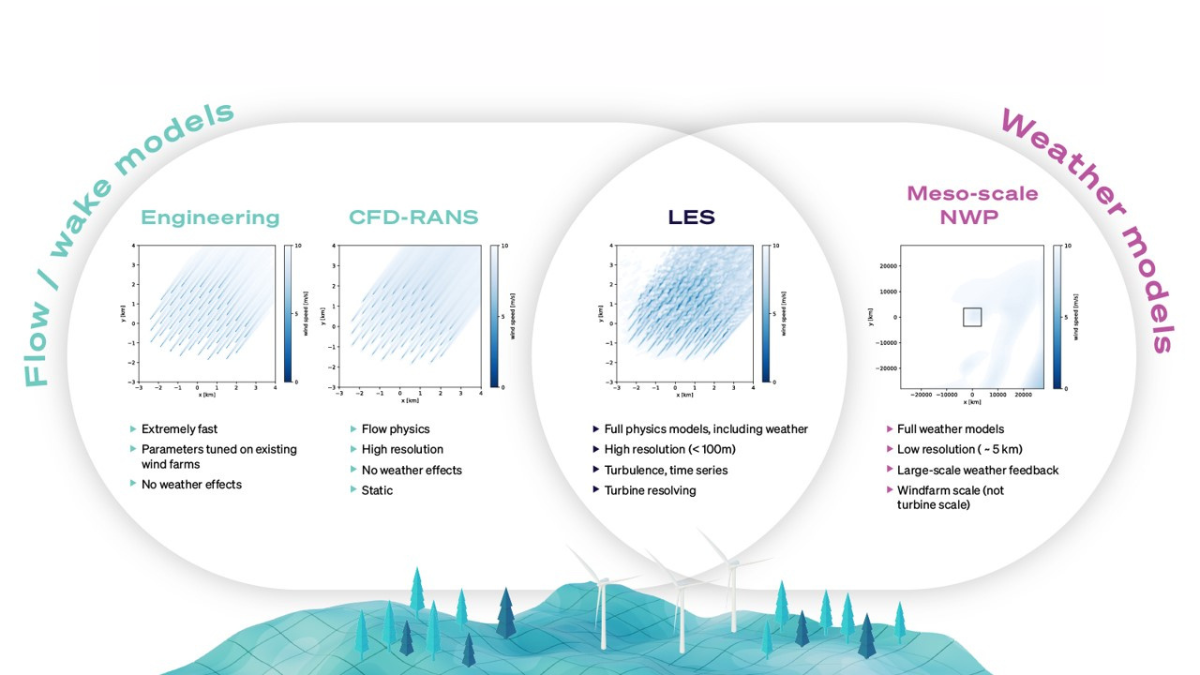
Wind resource engineers specializing in site evaluations and yield assessments use a range of modelling tools to identify optimal turbine layouts, analyze wind data, and predict energy yields for their wind farm projects.
These tools range from traditional engineering models to the more advanced CFD-RANS (Computational Fluid Dynamics – Reynolds-Averaged Navier-Stokes) models, the cutting-edge LES (Large-Eddy Simulation) models and the meso-scale models. Each approach provides distinct advantages, depending on terrain complexity and scale of the project.
In this article, we will examine the advantages, limitations, and practical applications of these four key approaches. With a focus on LES, we analyze why this method, known for its accuracy and resolution, is an indispensable tool when addressing the complex challenges of wind resource and yield modeling for today’s offshore and onshore wind energy projects.

In this blog, when we refer to LES models, we are specifically discussing atmospheric LES models due to their accuracy and applicability in wind energy applications.
The atmospheric LES model sets the benchmark in flow simulation technologies, using computational fluid dynamics (CFD) to simulate the evolution of the atmosphere on a computational grid with spatial resolutions typically ranging from 10 m to 100 m. In this approach, the LES directly simulates large scales of motions, while the sub-grid scheme takes care of small-scale turbulent transport. With atmospheric LES models, not only wind, but also temperature and humidity are simulated, significantly reducing reliance on assumptions about boundary layer height, atmospheric stability, and local turbulence variations.
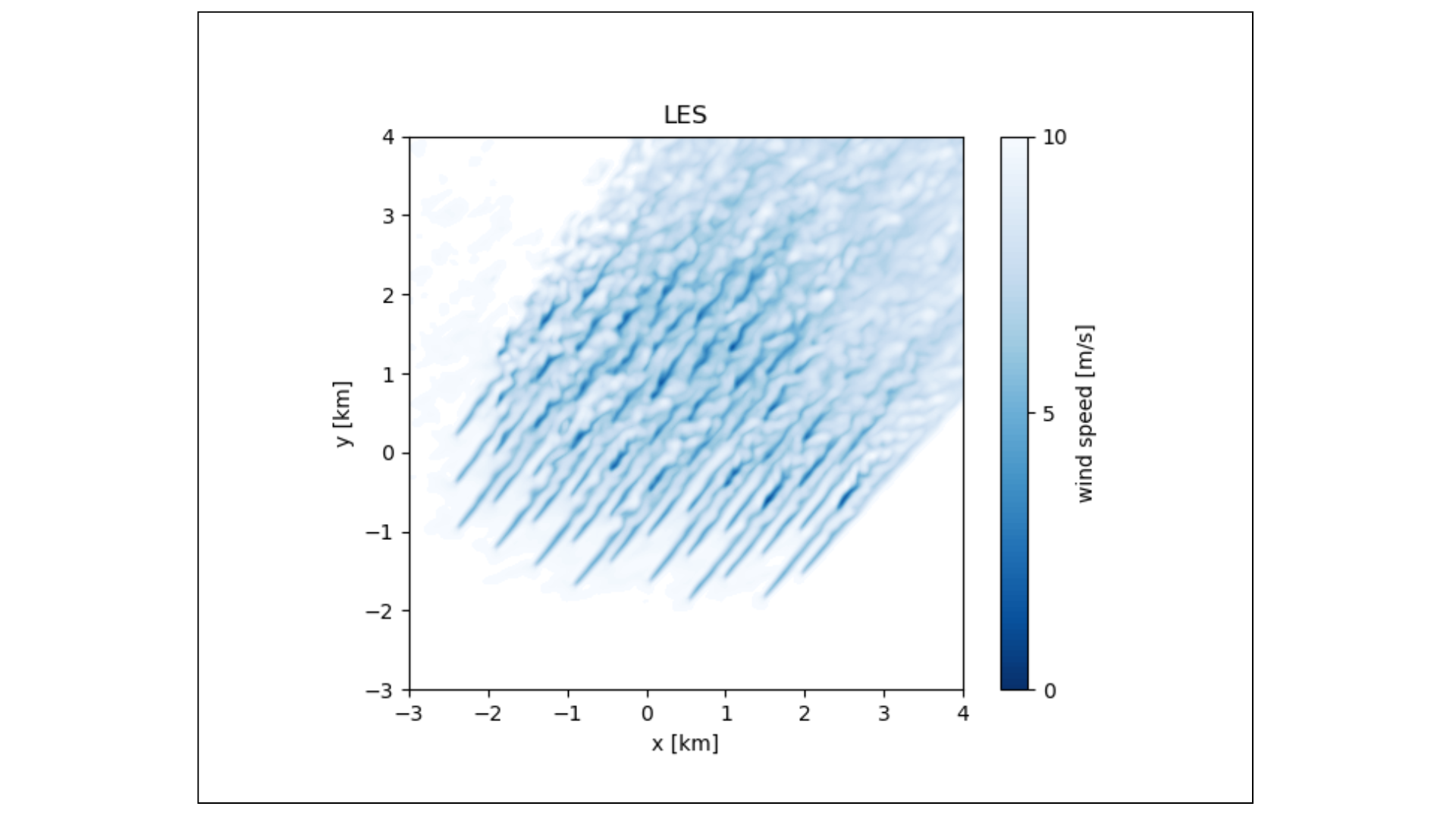
LES excels in providing full atmospheric simulations by integrating real weather data to enhance the accuracy of its predictions. LES models employ explicit turbulence modelling, capturing realistic shear, veer, gusts, and other turbulent phenomena crucial for precise turbine performance calculations. LES models significantly outperform other approaches when it comes to accurately computing aerodynamic losses. Unlike the simpler models that only approximate these phenomena, LES provides detailed simulations of turbine-atmosphere interactions, offering crucial insights into blockage effects and wakes and their impact on energy yield. Moreover, modern LES models that leverage advanced computing infrastructures can encompass very large domain sizes (up to 100s of kilometers), enabling comprehensive simulations of mesoscale phenomena like mountain flows, far wake effects and thermally driven atmospheric flows. More importantly, it can also capture wake effects of clusters of wind farms.
Some would argue that the LES models’ primary limitation is its computational intensity, which translates into higher computational costs and increased requirements for advanced computational infrastructure, such as high-performance servers or cloud computing resources. Additionally, the data handling and storage requirements for LES require solid data processing systems. Another barrier for the uptake of LES in wind farm modelling is often cited as the need for specialized knowledge to accurately interpret LES output and integrate it into practical wind farm design and planning.
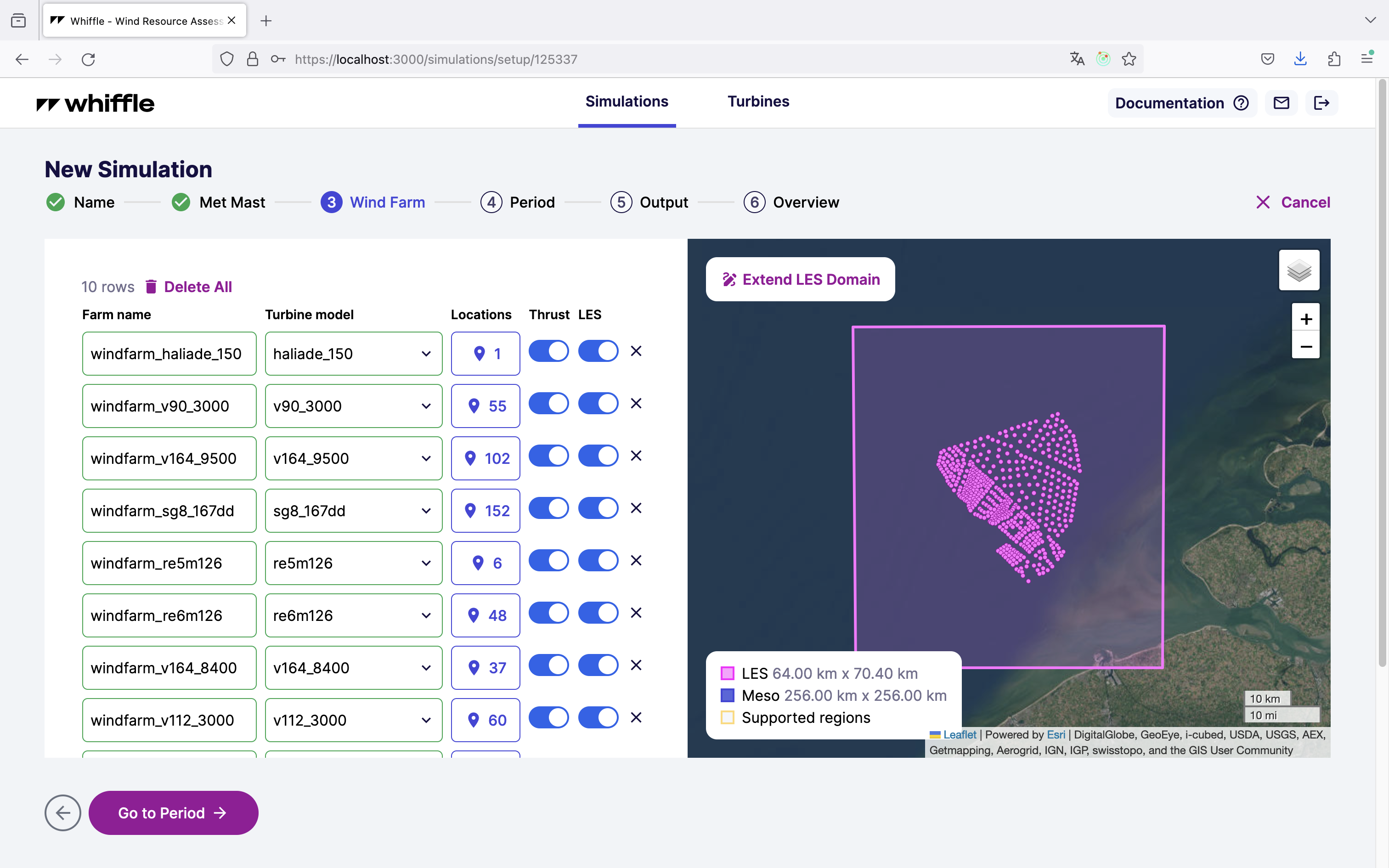
Whiffle Wind is a wind modelling tool revolutionizing the application of LES in the wind energy sector by overcoming the conventional challenges associated with LES-based wind modelling. Powered by Whiffle’s LES model, which leverages modern GPU computing power, Whiffle Wind reduces computational demands; lowering costs and accelerating simulation processing times to under 48 hours for a full year’s high-resolution simulation. Its user-friendly interface simplifies LES setup and execution, running simulations for specified domains using ERA5 historical weather data. You can also include turbines in your simulation. The result is an accurate simulation of atmospheric conditions during the specified runtime, at a 100m resolution, including power production values of individual turbines.
For onshore projects, LES is superior in complex terrains where orographic effects significantly impact wind patterns. It accurately captures these local details, leading to better answers for optimizing turbine siting, minimizing mechanical load risks, and maximizing energy yield—capabilities often lacking in other models. Offshore, LES models (which include turbines in their simulations) effectively quantify blockage and wakes, including the extended impacts of turbine wakes from neighboring farms. This is a critical factor frequently underestimated by conventional tools in the market. These capabilities ensure that projects that integrate LES into their wind are not only viable but also strategically optimized for sustained success in the competitive energy market.
Meso-scale models are valuable for studying and predicting weather phenomena over areas ranging from a few kilometers to several hundred kilometers. These models use the laws of physics and geoscientific data to simulate atmospheric behavior, bridging the gap between large-scale global models (e.g ECMWF’s IFS) and high-resolution, micro-scale models (e.g Whiffle’s LES model).
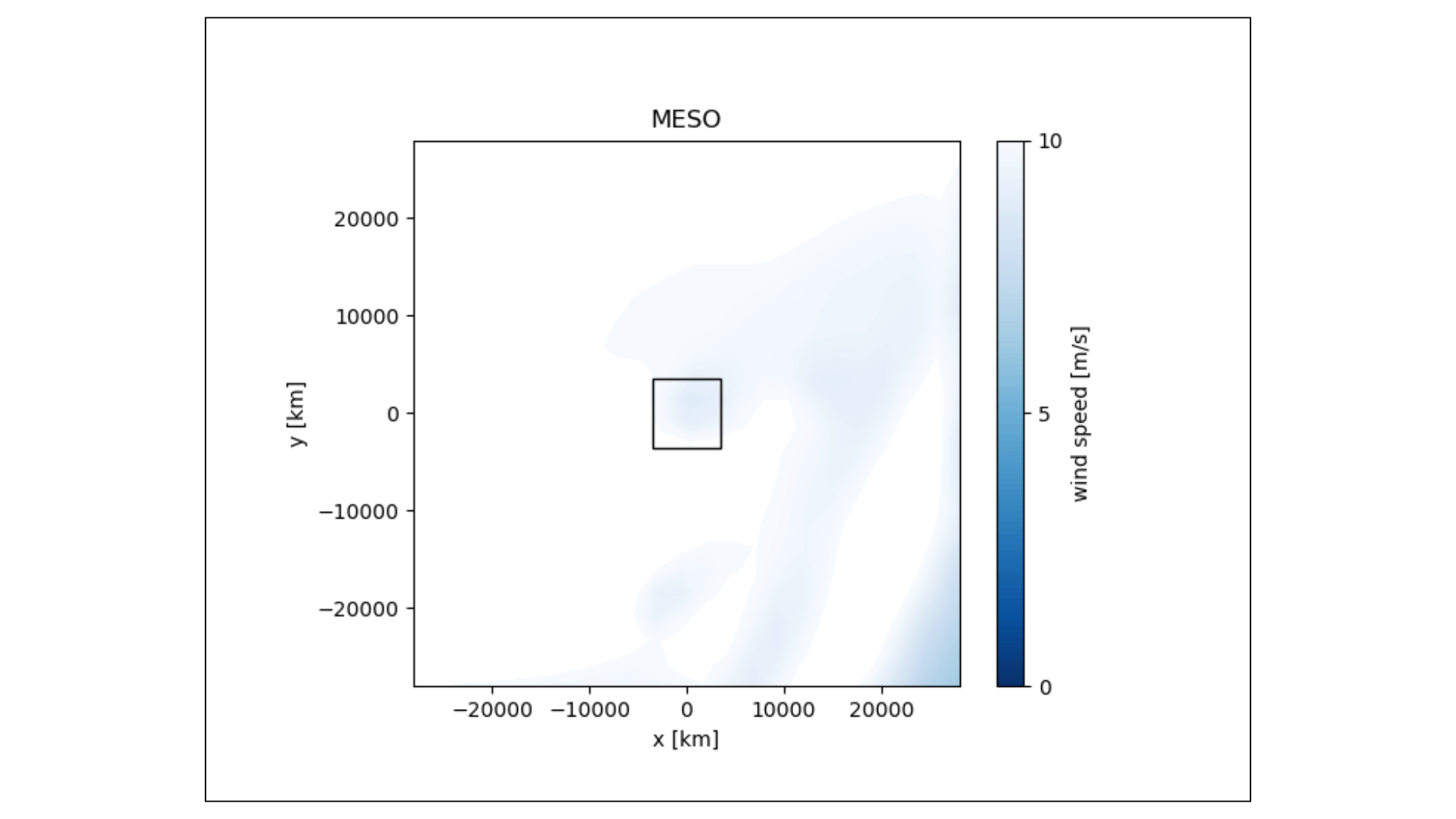
Meso-scale models excel in simulating atmospheric phenomena over large areas, providing an important link between global-scale weather predictions and local meteorological events like sea breezes and flows over mountainous terrain. Their ability to cover large domains (significant when you take into consideration the offshore wind capacity growth globally) and simulate a wide range of atmospheric interactions makes them useful for strategic, long-term planning in the wind energy sector. Mesoscale models with wind farm parameterizations are also used to study far wake effects.
Meso-scale models have coarser resolution than micro-scale models like the LES model. This can lead to inaccuracies in simulating small-scale atmospheric phenomena, which are crucial for site-specific wind resource and yield modelling. The coarser resolution might result in underestimations or overestimations of wind potential, especially in areas with complex terrain or significant orographic features. Additionally, these models rely on parameterization to represent sub-grid scale processes like turbulence and cloud enhanced mixing, potentially introducing errors if not well-tuned to the specific region. They also require substantial computational resources and data input, posing challenges for continuous, real-time applications. While mesoscale models are often run with wind farm parameterization, they cannot reliably be used for a wind farm’s internal wake losses, due to their coarse resolution.
Visualized below: representation of physical processes in LES and NWP

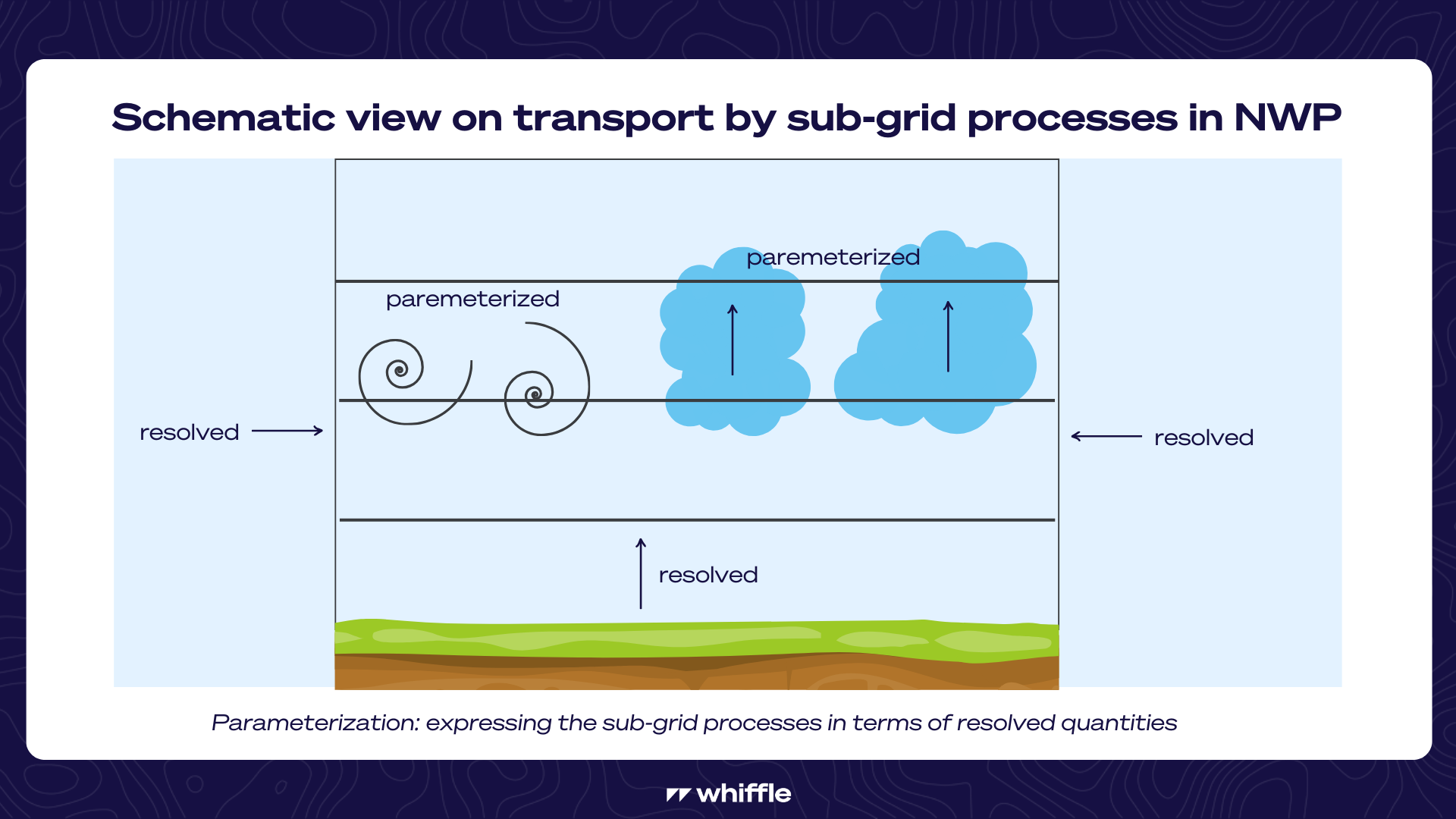
Meso-scale models are valuable for large-scale planning and preliminary site screening, helping to identify regions with promising wind resources. These models also play a role in environmental impact assessments, helping to secure project approvals by evaluating potential climatic impacts. For comprehensive project development, integrating meso-scale models with micro-scale tools like LES can optimize alignment of broad weather patterns with local conditions, enhancing overall turbine placement and energy yield strategies.
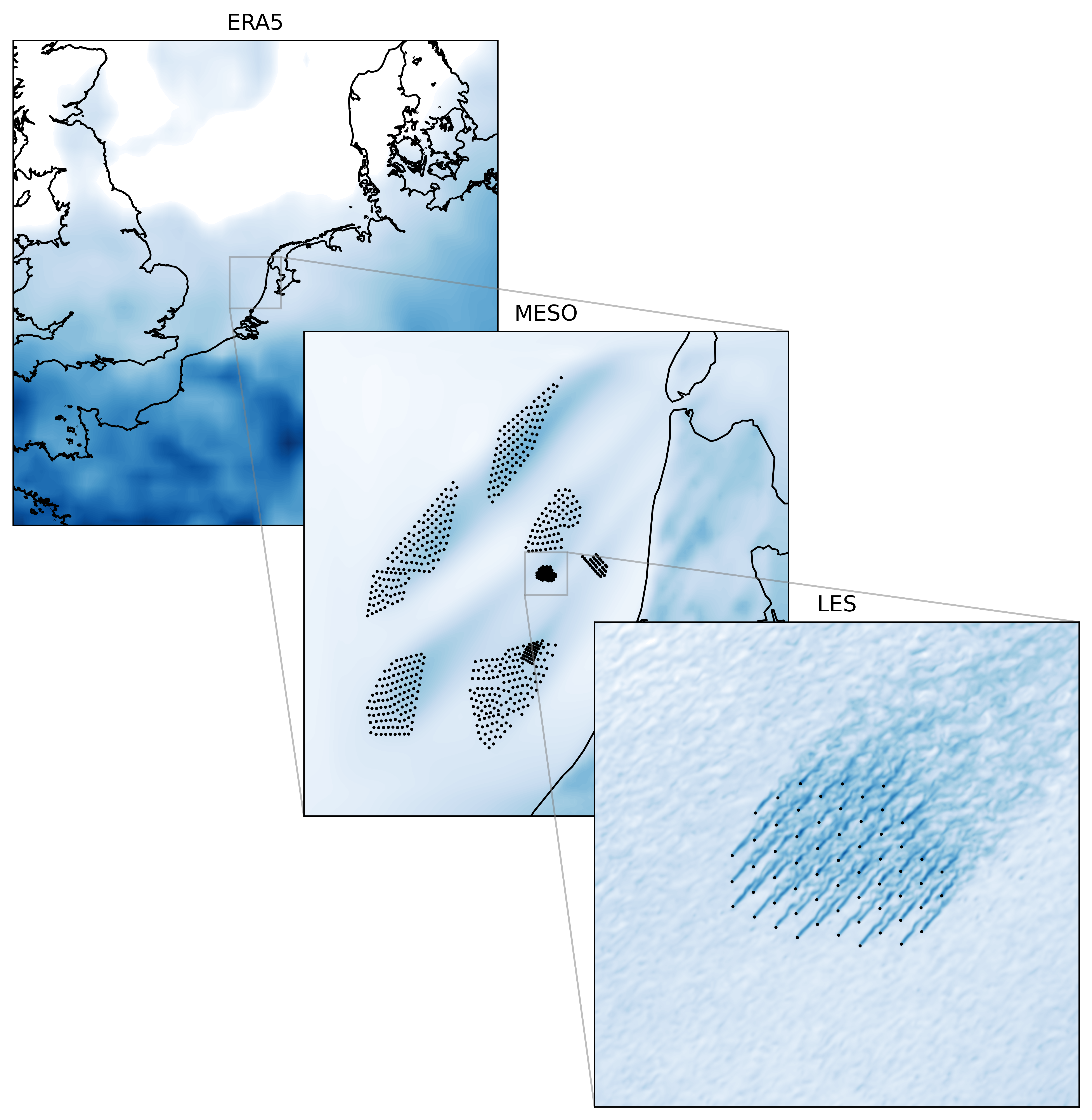
While historical ERA5 weather data effectively captures the largest scales (hundreds to thousands of km) and LES excels at simulating the smallest scales, it is the meso-scale that presents a significant challenge. To bridge this gap, Whiffle Wind incorporates a meso-scale model that runs at a resolution of 2 km within a 256 km by 256 km domain, adeptly capturing effects such as land-sea transitions and large-scale orography. This meso-simulation drives the LES, providing more realistic boundary conditions, and serves as a critical component in delivering accurate, site-specific wind resource assessments, particularly in complex terrains.
CFD-RANS models utilize computational fluid dynamics to simulate wind flow patterns, especially around physical obstacles within the velocity field. These models are particularly valuable in studies where detailed interactions with terrain features and wind turbines are critical. CFD-RANS models offer a generalized approach to wake modeling.
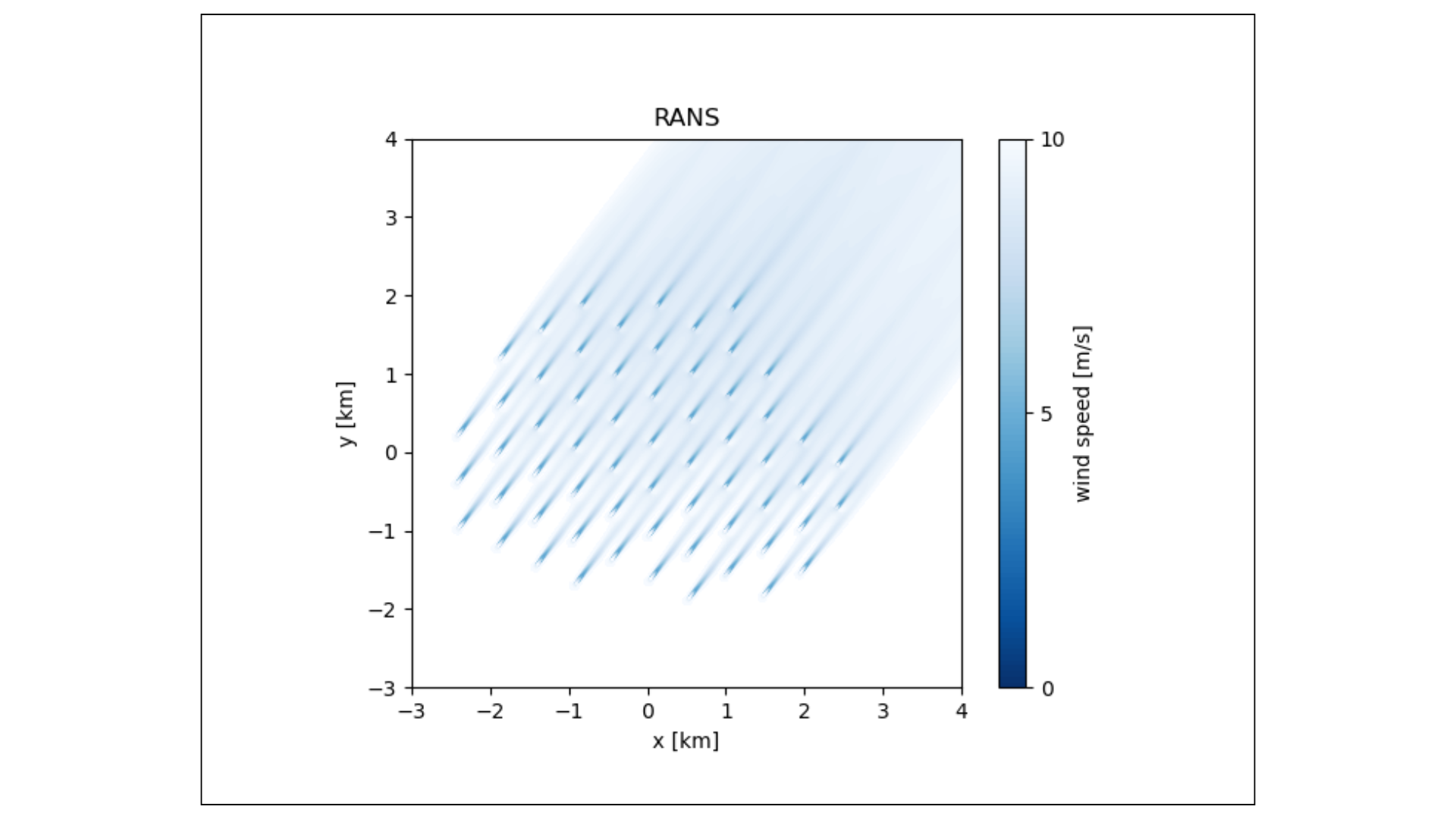
CFD-RANS models provide a representative simulation of airflow dynamics and offer flexibility in the choice of computation mesh, enabling detailed resolution enhancements as needed. Often used in conjunction with mesoscale or reanalysis input data, they can capture the small-scale flow details of the site climatology. Based on the conservation equations for momentum, CFD-RANS does account for flow phenomena like global blockage.
A primary drawback of CFD-RANS lies in its inability to accurately capture the dynamics of more complex atmospheric flows where thermal effects like stratification, boundary layer height and convection play a role. Additionally, these models are constrained by limited domain sizes, resulting in extended run times and considerable computational expenses. Moreover, they may not effectively generalize to all atmospheric conditions, and their wake modeling relies on approximations, compromising the precision of yield predictions. The fact that they are used in a ‘steady state’ manner, with prescribed wind speed and direction, means they miss essential wake propagation features like wake meandering, leading to overly narrow wake effects.
CFD-RANS models are suitable for sites with moderate complexity, outperforming basic engineering models in both detail and adaptability. They provide useful insights into wind flow patterns and wake effects but may not be suitable for optimizing energy production in highly complex terrains (e.g. urban or coastal environments where microscale dynamics or thermal effects dominate, or sites with irregular topography). In such cases, a higher-fidelity model may provide better results.
Traditional engineering models are foundational tools in wind resource assessment, primarily developed from empirical observations. They operate under simplified assumptions such as uniform wind flow and static atmospheric conditions, enabling quick computations. However, these models typically generate wind profiles that may not accurately reflect site-specific conditions.
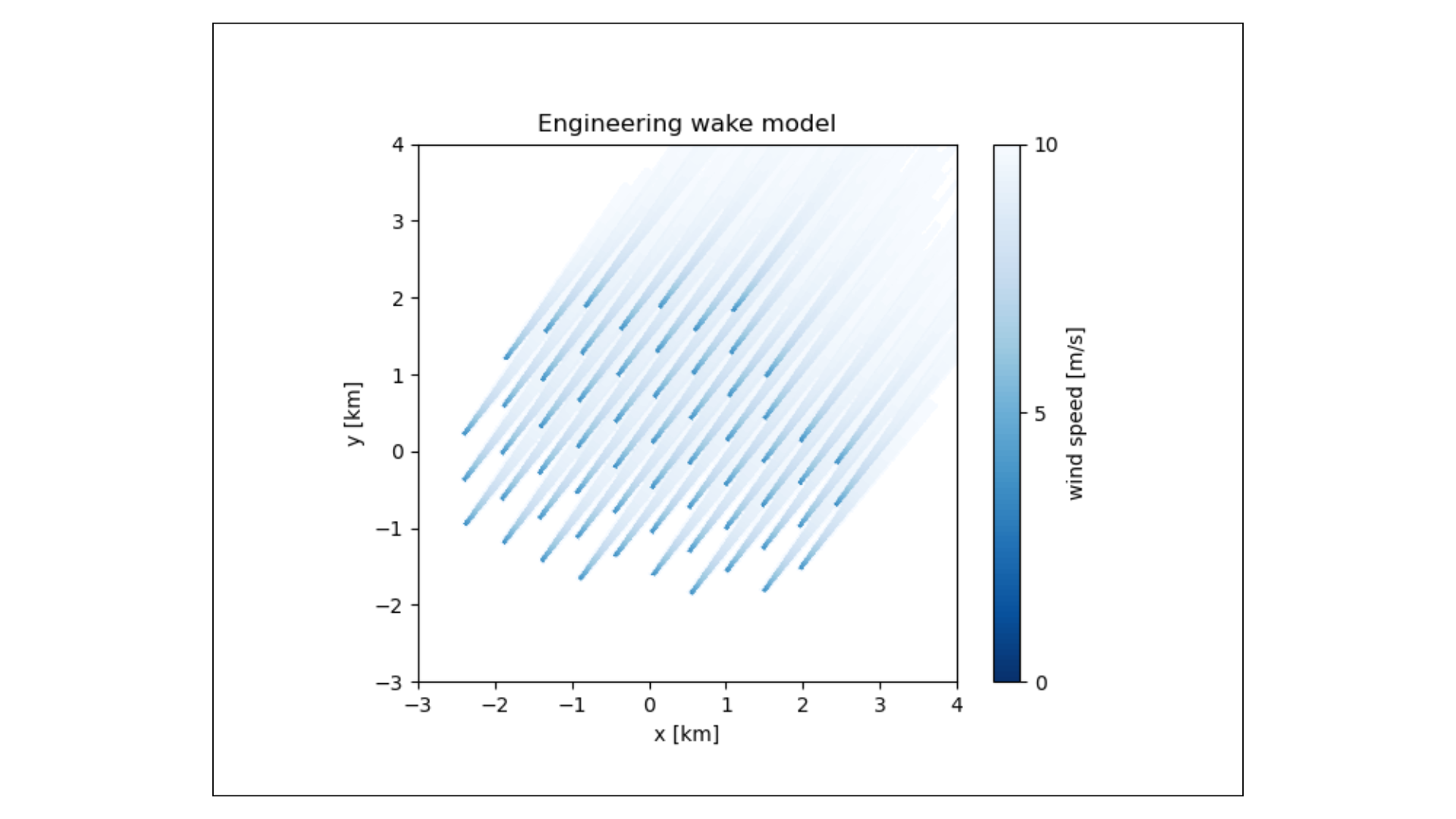
Engineering models are valued for their ability to conduct fast simulations, making them ideal for optimizing algorithms. They also produce outputs that are easy to interpret. Despite their limited accuracy, the long-standing use of these models in the industry allows engineers to make effective empirical adjustments, providing a relatively reliable baseline for preliminary analysis.
Engineering models lack the detailed physics needed for modeling complex atmospheric flows, such as scenarios involving turbulent wind conditions, obstacles, or varied topography. Additionally, due to their assumed wake structure and calibration on historical wind farm data, they have a limited ability to accurately simulate wakes and blockage, especially for larger wind farms and clusters of wind farms.
This technique is best used in the early exploration phase of project development and particularly in simpler terrains where environmental and atmospheric complexities are minimal. By leveraging these models, wind energy analysts can quickly evaluate site suitability and candidate wind farm layouts and lay the groundwork for further detailed analysis (using advanced simulations tools, for successful project implementation.
In an industry where precision drives profitability, choosing the right simulation technology is key for wind farm project success. Engineering models, while foundational, often fall short of addressing the ever-changing demands of today’s wind farm development. In contrast, the LES approach – particularly the one implemented in Whiffle Wind, delivers the precision and resolution needed for managing the real-world challenges of today’s wind farm projects.
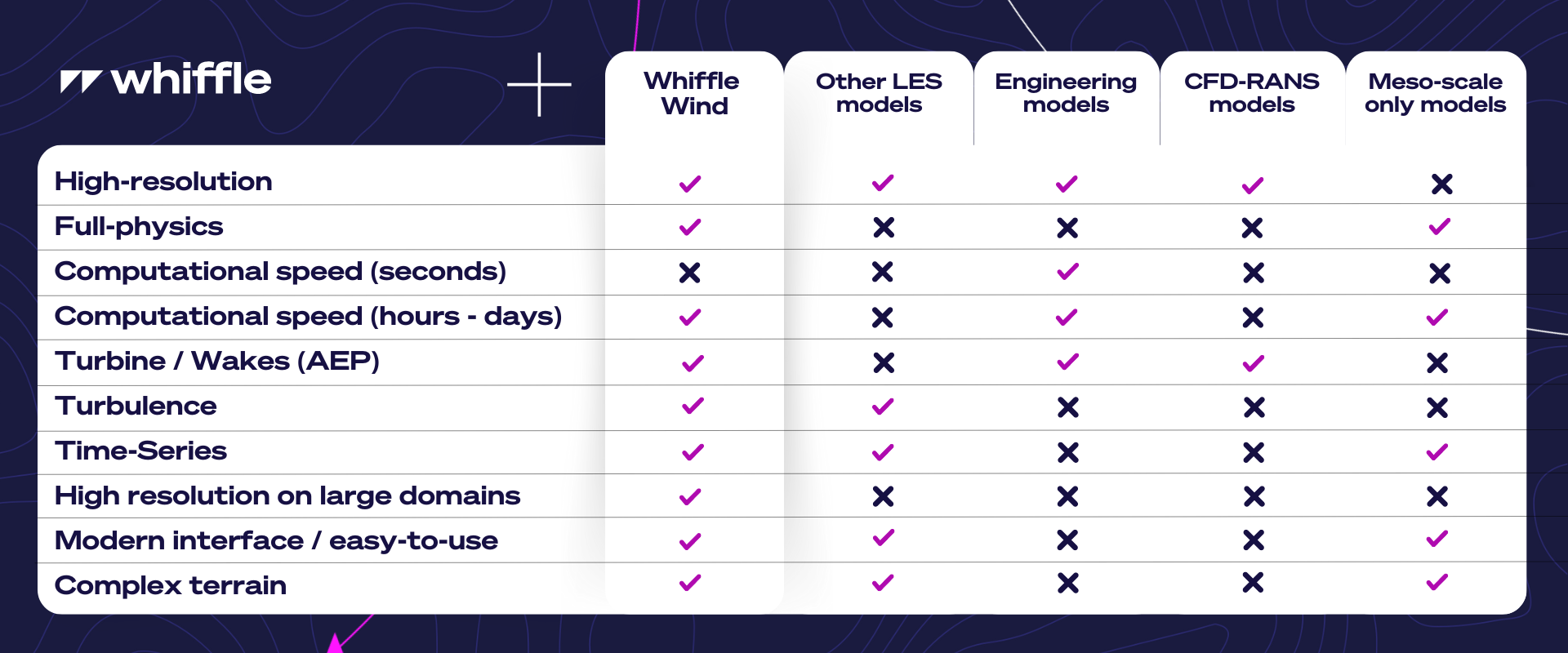
These include modelling for complex terrains, challenging wind conditions, and optimizing offshore wind farms that are closely clustered. Such scenarios are increasingly prevalent in the current landscape of the global wind energy sector, making advanced simulation tools like Whiffle Wind, the standard for achieving operational efficiency and maximizing project profitability.
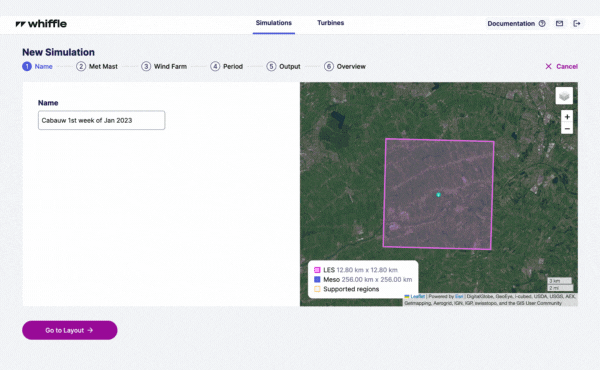
Getting started is easy. Get your free trial today.
Interested in getting some free credits? Fill out the form below, and we’ll get in touch with you promptly!